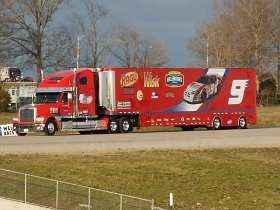Going From A School Bus Driver To A Tractor Trailer Driver
Topic 25334 | Page 2

Yes, no comparison to driving a car. But similarities between buses and tractor trailers. Wide turns, sitting up high, very large vehicle, pre/post trips, height concerns, much longer stopping distances, scheduled routes, navigating new routes, etc. Granted there's a lot of differences but, I see some similarities.
There are just a few similarities. None of which will give you an advantage.
Maybe. I think it will be an easier transition going from a bus than from a car. Anywho, we shall see.
Rob R wrote:
I’ve been a school bus driver, in upstate New York, for several years. Now I’m thinking of getting my CDL-A. If I attend a company sponsored training program, will the training be any shorter/easier since I already have a CDL-B?
Thanx,
Bob
The one habbit I've found difficult to break was transitioning from Push - Pull steering to plaming the wheel to steer especially when I would make a turn or when I back up spinning the wheel fast enough when I need my tractor to chase the trailer. I'm either too slow or too fast.
CDL:
Commercial Driver's License (CDL)
A CDL is required to drive any of the following vehicles:
- Any combination of vehicles with a gross combined weight rating (GCWR) of 26,001 or more pounds, providing the gross vehicle weight rating (GVWR) of the vehicle being towed is in excess of 10,000 pounds.
- Any single vehicle with a GVWR of 26,001 or more pounds, or any such vehicle towing another not in excess of 10,000 pounds.
- Any vehicle, regardless of size, designed to transport 16 or more persons, including the driver.
- Any vehicle required by federal regulations to be placarded while transporting hazardous materials.
Company Sponsored Training:
A Company-Sponsored Training Program is a school that is owned and operated by a trucking company.
The schooling often requires little or no money up front. Instead of paying up-front tuition you will sign an agreement to work for the company for a specified amount of time after graduation, usually around a year, at a slightly lower rate of pay in order to pay for the training.
If you choose to quit working for the company before your year is up, they will normally require you to pay back a prorated amount of money for the schooling. The amount you pay back will be comparable to what you would have paid if you went to an independently owned school.
Company-sponsored training can be an excellent way to get your career underway if you can't afford the tuition up front for private schooling.

Maybe. I think it will be an easier transition going from a bus than from a car. Anywho, we shall see.
Maybe? More like maybe not...
Bus - about 40’, Semi 72’ Bus - 26,000lbs, Semi up to 80,000lbs Bus - Windows on all 4 sides, Semi - windshield and door windows Bus - about 10’ high, Semi 13’6” high Bus - easy to back, Semi very difficult to back. Bus - training 1 day, Semi training is minimally 3 weeks just for basic CDL school. Add minimally another few weeks for road training.
You are driving the bus, we drive the trailer. Huge and very humbling difference.
You asked for truthful answers, you got many. Not here to debate this, trying to ground your expectations. To reiterate the similarities are few, and your experience does not provide an easier path to earning the CDL A.
CDL:
Commercial Driver's License (CDL)
A CDL is required to drive any of the following vehicles:
- Any combination of vehicles with a gross combined weight rating (GCWR) of 26,001 or more pounds, providing the gross vehicle weight rating (GVWR) of the vehicle being towed is in excess of 10,000 pounds.
- Any single vehicle with a GVWR of 26,001 or more pounds, or any such vehicle towing another not in excess of 10,000 pounds.
- Any vehicle, regardless of size, designed to transport 16 or more persons, including the driver.
- Any vehicle required by federal regulations to be placarded while transporting hazardous materials.

Hey G town, I couldn't find a message option. But since you drive for Swift could you shed some light on their pet policy? I want to bring my cat once I become a solo driver, would I be able to? Thanks
Granted school buses and 18 wheelers are different but, compared to driving a car I see several similarities.
Care to explain what you mean by this?
Driving a car is absolutely nothing like driving a tractor trailer.

Well this may be the only area where I can offer a little help. I, too, transitioned from school bus to tractor. For me, the hardest thing was getting the backing down. The length, wide turns, and all are basically the same just a little wider and longer. My bus was an automatic but I fussed all the time wanting a manual. So the manual part for me was a breeze. Just take your time and take as much room as possible. Best advise given to me when training; take all that you can when turning because you can give a little but if you take too little you can’t take anymore once you have committed.
If you learned double clutching in a bus, you still have it. (I did - with a 30+ year gap between school bus and 18 wheeler.)
Steering is a different story. While teaching at Swift Academy, I saw experienced Greyhound drivers not pass some basic backing maneuvers. Twice.
Double Clutch:
To engage and then disengage the clutch twice for every gear change.
When double clutching you will push in the clutch, take the gearshift out of gear, release the clutch, press the clutch in again, shift the gearshift into the next gear, then release the clutch.
This is done on standard transmissions which do not have synchronizers in them, like those found in almost all Class A trucks.
Double Clutching:
To engage and then disengage the clutch twice for every gear change.
When double clutching you will push in the clutch, take the gearshift out of gear, release the clutch, press the clutch in again, shift the gearshift into the next gear, then release the clutch.
This is done on standard transmissions which do not have synchronizers in them, like those found in almost all Class A trucks.
TWIC:
Transportation Worker Identification Credential
Truck drivers who regularly pick up from or deliver to the shipping ports will often be required to carry a TWIC card.
Your TWIC is a tamper-resistant biometric card which acts as both your identification in secure areas, as well as an indicator of you having passed the necessary security clearance. TWIC cards are valid for five years. The issuance of TWIC cards is overseen by the Transportation Security Administration and the Department of Homeland Security.

Yes, no comparison to driving a car. But similarities between buses and tractor trailers. Wide turns, sitting up high, very large vehicle, pre/post trips, height concerns, much longer stopping distances, scheduled routes, navigating new routes, etc. Granted there's a lot of differences but, I see some similarities.
Testing/learning the pre-trip alone puts you far ahead. Navigating a large vehicle and dealing with tail swing will help too. You know a lot of what to look for over the guy who just drives a Pinto.

Yes, no comparison to driving a car. But similarities between buses and tractor trailers. Wide turns, sitting up high, very large vehicle, pre/post trips, height concerns, much longer stopping distances, scheduled routes, navigating new routes, etc. Granted there's a lot of differences but, I see some similarities.
Testing/learning the pre-trip alone puts you far ahead. Navigating a large vehicle and dealing with tail swing will help too. You know a lot of what to look for over the guy who just drives a Pinto.
Far ahead? I respectfully disagree.
PTI on.tractor trailer is way more complex than a bus.
I maintain my original reply.
New Reply:
New! Check out our help videos for a better understanding of our forum features

















Preview:
This topic has the following tags:
Becoming A Truck Driver Pre-trip inspection (PTI) Trailers Truck Equipment







 TT On Facebook
TT On Facebook
Yes, no comparison to driving a car. But similarities between buses and tractor trailers. Wide turns, sitting up high, very large vehicle, pre/post trips, height concerns, much longer stopping distances, scheduled routes, navigating new routes, etc. Granted there's a lot of differences but, I see some similarities.